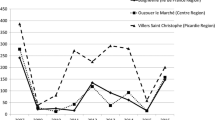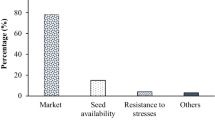Abstract
The Australian cotton industry has developed rapidly since the early 1960s when irrigation became available. Bacterial blight and Verticillium wilt have been present in Australia for many years and with Phytophthora boll rot have caused significant yield reductions. However, production areas have been kept free of several potentially important plant pathogens. More virulent races and strains of the blight and wilt pathogens have developed overseas and the introduction of these must be prevented. Standard plant quarantine procedures have achieved the level of protection required by the Australian cotton industry with the possible exception of the introduction of races of the bacterial blight pathogen by symptomless epiphytic transfer, The quarantine dilemma is whether to provide conditions favouring pathogen expression or to attempt to minimise the growth and development of the pathogen and other epiphytic micro-organisms, if present. The presence of soil and/or plant material on second-hand machinery imported from overseas constitutes a weak link in quarantine effectiveness. Second-hand machinery should be thoroughly cleaned prior to importation and carefully inspected by quarantine officers on arrival. The efficacy and feasibility of fumigation could be considered.
Similar content being viewed by others
References
Allen, S.J. (1986) — Bacterial blight of cotton 1984–85. New South Wales Department of Agriculture, Biology Branch Plant Disease Survey (1984–85). pp. 31–32.
Allen, S.J. (1990) — The world of disease: pathology, breeding and management. In Proceedings of the Fifth Australian Cotton Conference, Broadbeach, Queensland. pp. 61–66. Australian Cotton Growers Research Association.
Allen, S.J. and West, K-L.D. (1987) — Diseases of Cotton in New South Wales during the 1985-86 Season. New South Wales Department of Agriculture, Biology Branch Plant Disease Survey (1985–86). pp. 27–30.
Brinkerhoff, L.A. and Hunter, R.E. (1963) — Internally infected seeds as a source of inoculum for the primary cycle of bacterial blight of cotton. Phytopathology 53: 1397–1401.
Brinkerhoff, L.A. and Presley, J.T. (1967) — Effect of four day and night temperatureregimes on bacterial blight reactions of immune, resistant and susceptible strains of upland cotton. Phytopathology 57: 47–51.
Brinkerhoff, L.A.; Verhalen, L.M.; Johnson, W.M.; Essenberg, M. and Richardson, P.E. (1984) — Development of immunity to bacterial blight of cotton and its implications for other diseases. Plant Disease 68: 168–173.
Bush, D.L. (1984) — Report of the Bacterial Blight Committee. Proceedings Beltwide Cotton Production Research Conference. pp. 4–5. National Cotton Council of America.
Dowling, D. (Editor) (1989) — Cotton Yearbook 1989. The Australian Cottongrower.
Dowling, D. (Editor) (1992) — Cotton Yearbook 1992. The Australian Cottongrower.
Dowling, D. (Editor) (1994) — Cotton Yearbook 1994. The Australian Cottongrower.
Evans, G. and Paull, R. (1967) — Incidence and distribution of verticillium wilt in cotton crops in the Namoi Valley. Journal of the Australian Institute of Agricultural Science 33: 210–212.
Fahy, P.C. and Cain, P. (1987) — Races of bacterial blight, Xanthomonas campestris pv. malvacearum, present in Australian cotton crops in 1964–1980. Australasian Plant Pathology 16: 17–18.
Follin, J.C. (1983) — Races of Xanthomonas campestris pv. malvacearum (Smith) Dye in Western and Central Africa. Coton et Fibres Tropicales 38: 277–279.
Imes, N.L. (1983) — Bacterial Blight of Cotton. Biological Reviews 58: 157–176.
Kochman, J.K., Pegg, K.G., Davis, R.D., Moore, N. Y. and Bentley, S. (1994) — Fusarium wilt in cotton on the Darling Downs in Queensland. In Proceedings of the Seventh Australian Cotton Conference, Broadbeach, Queensland. pp. 265-269.
Leben, C. (1981) — How plant pathogenic bacteria survive. Plant Disease 65: 633–637.
Moffett, M.L. (1982) — The Epidemiology of Bacterial Blight of cotton caused by Xanthomonas campestris pv. malvacearum. Australian Cotton Growers Research Association Annual Research Report. pp. 151–157.
Moffett, M.L. and Wood, B.A. (1984) — Resident population of Xanthomonas campestris pv malvacearum on cotton leaves: a source of inoculum for bacterial blight. Journal of Applied Bacteriology 58: 607–612.
Navaratnam, S.J., Shuttleworth, D. and Wallace, D. (1980) — The effect of aerated steam on six seed-borne pathogens. Australian Journal of Experimental Agriculture and Animal Husbandry 20: 97–101.
Schnathorst, W.C. (1968) — Introduction ofXanihomonus malvacearum into California in acid-delinted and fumigated cotton seed. Plant Disease Reporter 52: 981–982.
Schnathorst, W.C. and Evans, G. (1971) — Comparative virulence of American and Australian isolates of Verticillium albo-atrum in Gossypium hirsutum. Plant Disease Reporter 55: 977–980.
Watkins, G.M. (Editor) (1981) — Compendium of Cotton Diseases. The American Phytopathological Society, St. Paul.
Wrather, J.A., Sappenfield, W.P. and Baldwin, C.H. (1986) — Colonization of cotton buds by Xanthomonus campestris pv. malvacearum. Plant Disease 70: 551–552.
Author information
Authors and Affiliations
Rights and permissions
About this article
Cite this article
Allen, S.J. Plant quarantine and diseases of cotton. Australasian Plant Pathology 24, 70–73 (1995). https://doi.org/10.1071/APP9950070
Accepted:
Issue Date:
DOI: https://doi.org/10.1071/APP9950070




